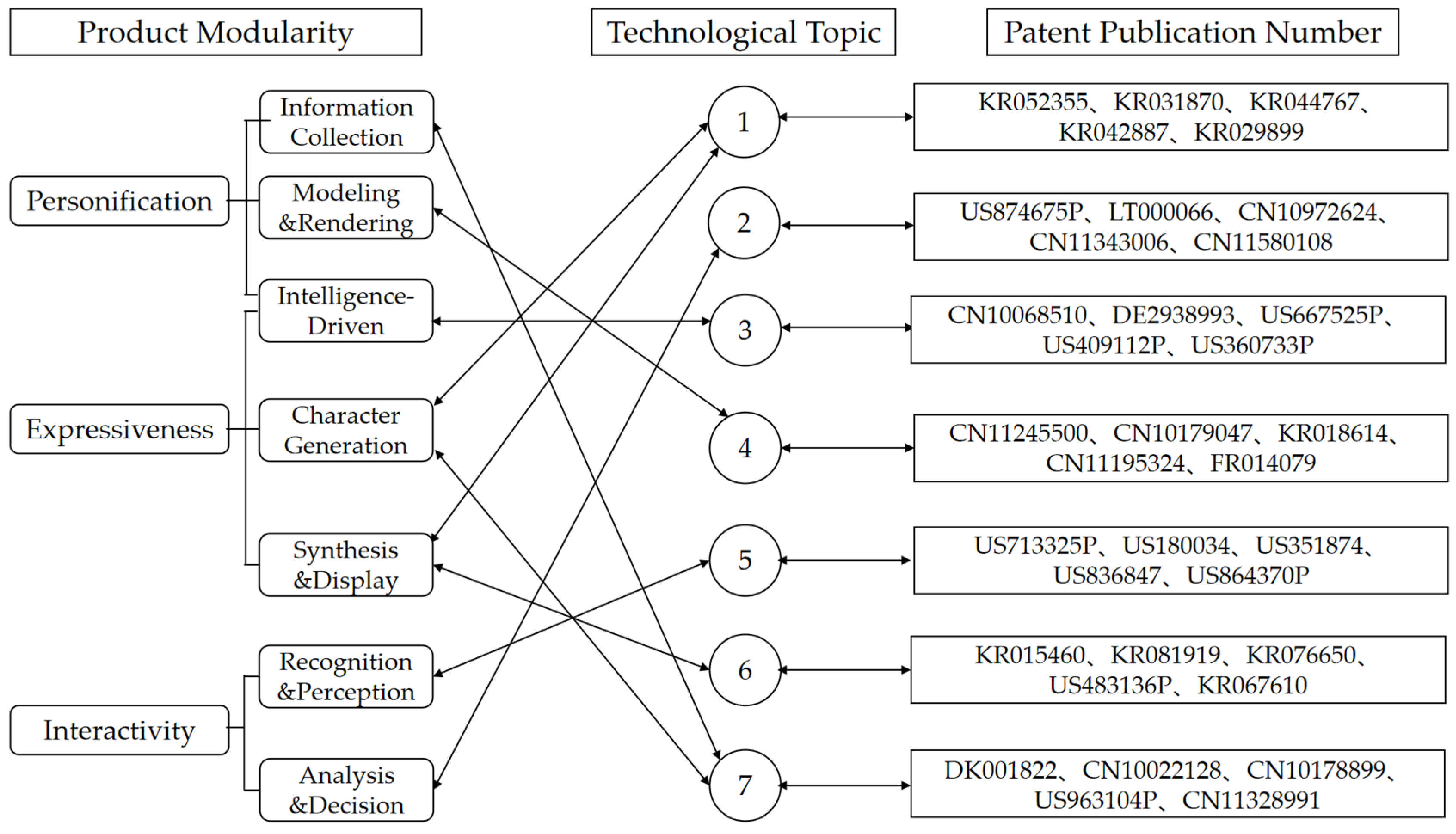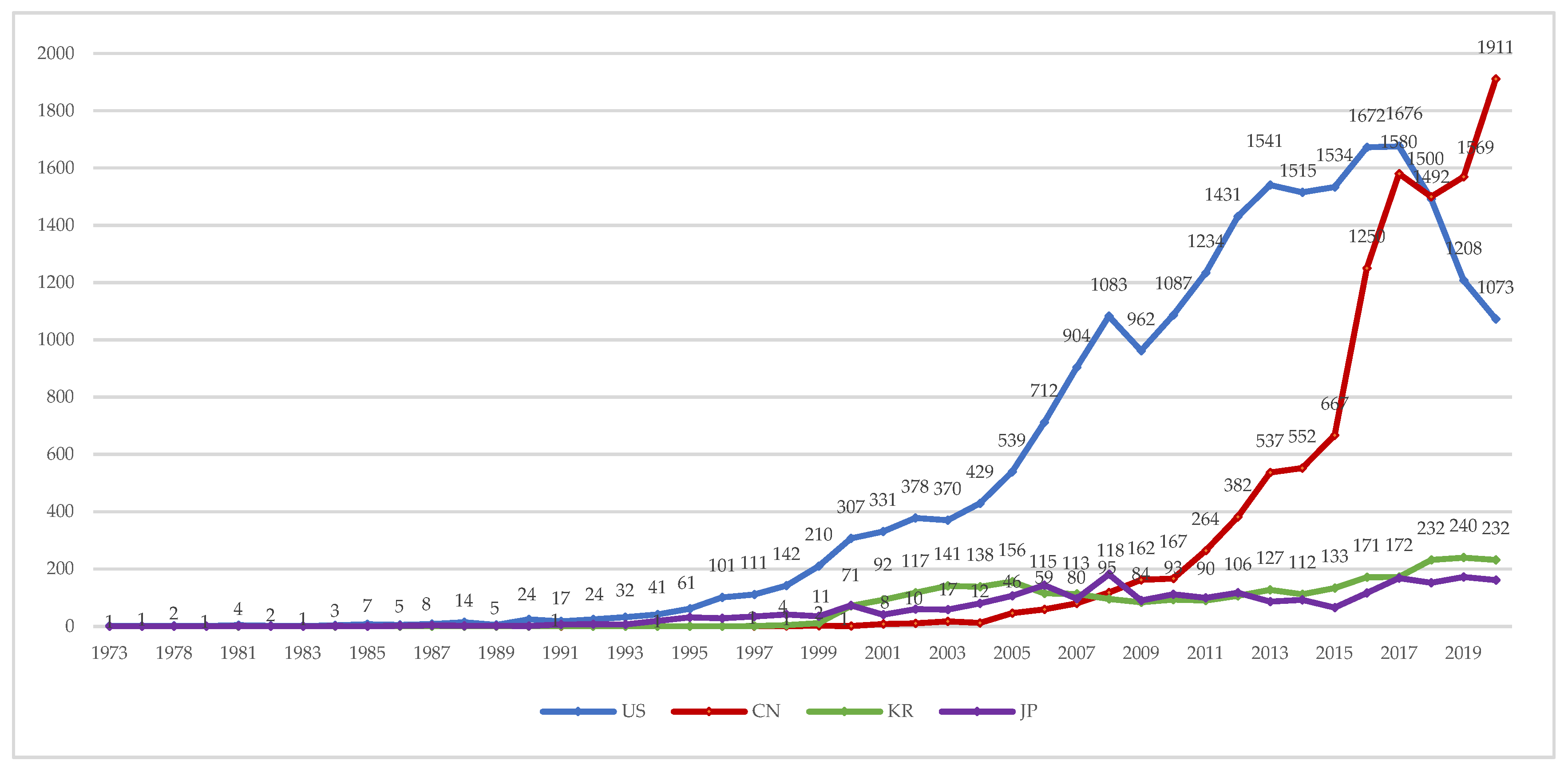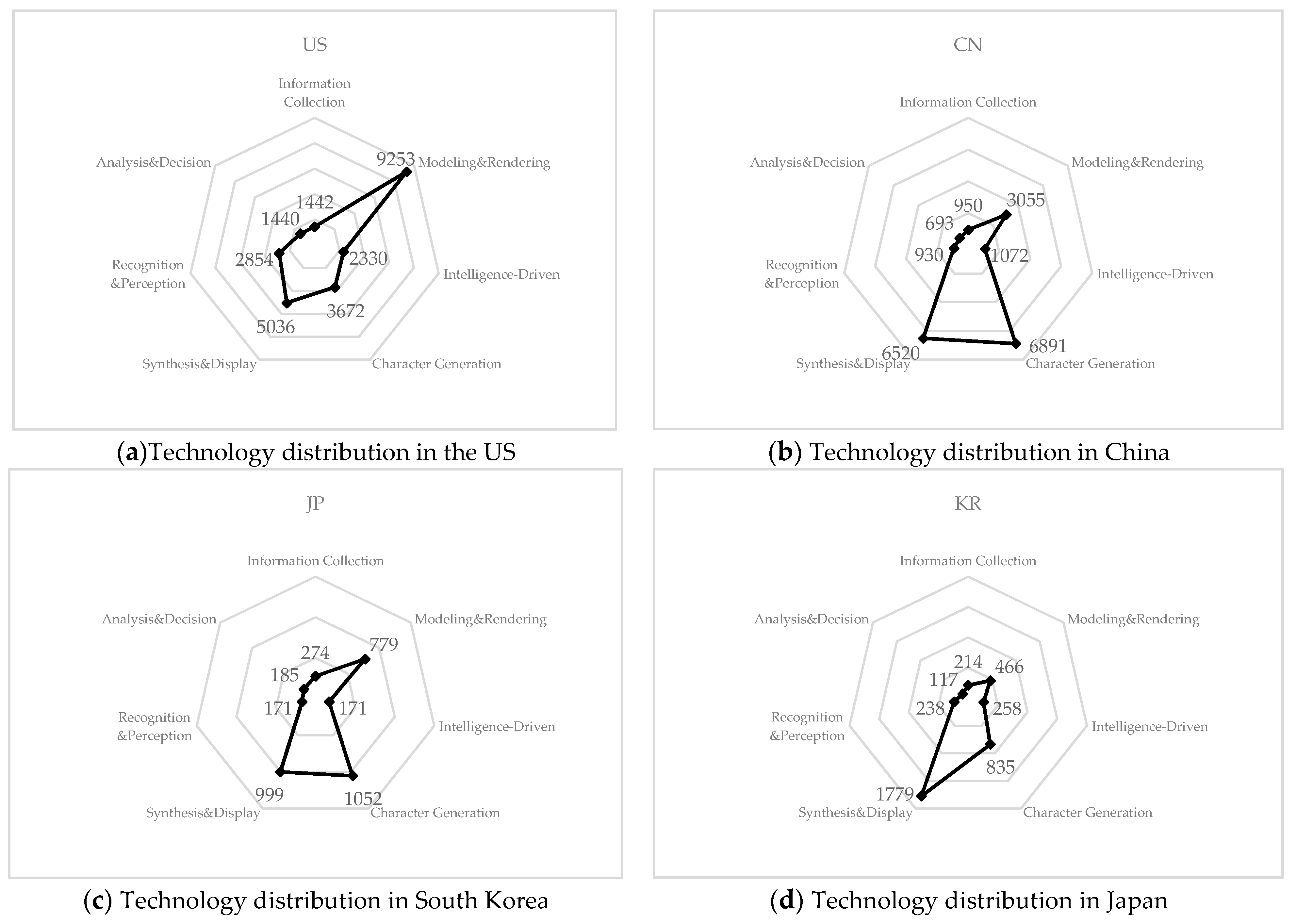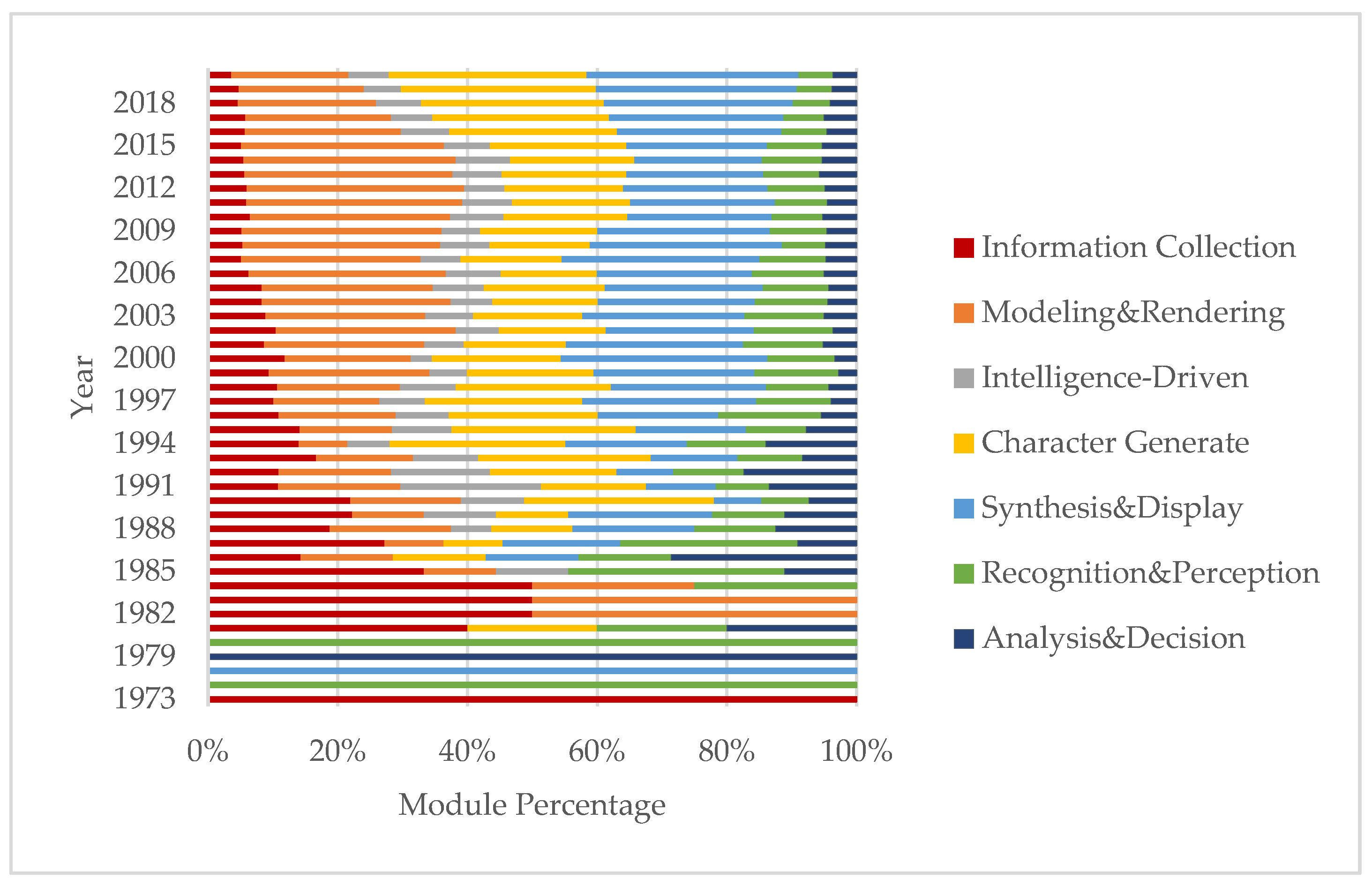Technical Trends and Competitive Situation in Respect of Metahuman—From Product Modules and Technical Topics to Patent Data
Abstract
:1. Introduction
- How do we identify metahuman product modules and relevant technology patents?
- Which countries are more actively adopting metahuman technology and developing more advanced technology?
- How is metahuman technology evolving over time?
2. Literature Review
2.1. Metahuman
2.2. Division Rules of Product Modularity
2.3. Technical Topic Identification of Patents
3. Materials and Methods
3.1. Research Framework
3.2. Source and Filtering for Data
3.3. Metahuman Product Modularity
3.4. Technical Topic Analysis of Patent Text
3.5. Matching Product Modularity, Technical Topics, and Patent Data
4. Results
4.1. Technology Trends
4.2. Geographical Layout
4.3. Technological Revolution
5. Conclusions
5.1. Discussion
5.2. Theoretical and Practical Implications
5.3. Limitations and Future Research Directions
Author Contributions
Funding
Institutional Review Board Statement
Informed Consent Statement
Data Availability Statement
Conflicts of Interest
References
- Xie, J. Virtual Broadcasters at Beijing Winter Olympics Offer a Glimpse into China’s Rapid Developing Industry. Available online: https://www.globaltimes.cn/page/202202/1252209.shtml (accessed on 30 November 2022).
- Guo, Q.Z. The Present, Key and Future of Virtual Digital Human Development. News Writ. 2022, 7, 56–64. [Google Scholar]
- Research and Markets Global Intelligent Virtual Assistant Market (2020 to 2027)—Size, Share & Trends Analysis Report. Available online: https://www.businesswire.com/news/home/20200422005328/en/Global-Intelligent-Virtual-Assistant-Market-2020-2027 (accessed on 4 December 2022).
- Shen, H.; Liu, T.L. The Virtual Reality Blends with the Real, as if It Were Separate: The Virtual Digital Person in Full Attack. Broadcast. Realm 2022, 3, 5–10. [Google Scholar]
- Chen, L.Q.; Zhang, L.J. Virtual Digital Human 3.0: The Meta-Universe Era of Human Symbiosis; China Translation & Publishing House: Beijing, China, 2022. [Google Scholar]
- Sookkaew, J.; Saephoo, P. “Digital Influencer”: Development and Coexistence with Digital Social Groups. Int. J. Adv. Comput. Sci. Appl. 2021, 12, 326–332. [Google Scholar] [CrossRef]
- Huang, S.Z.; Wang, J.X. Research on the Application of Human-Computer Interaction Technology in Virtual Idols. Media 2021, 23, 51–53. [Google Scholar]
- Yang, M.Y.; Yu, G.M. Empowerment and “Soul Empowerment”: The Personalized Construction of Digital Avatars. Editor. Friend 2022, 42, 44–50. [Google Scholar]
- Yu, X.; Shi, Y.; Yu, H.; Liu, T.; An, J.; Zhang, L.; Su, Y.; Xu, K. Digital Human Modeling and Its Applications: Review and Future Prospects. J. X-ray Sci. Technol. 2015, 23, 385–400. [Google Scholar] [CrossRef] [PubMed]
- Park, J.H.; Lee, G.-H.; Moon, D.-N.; Yun, K.-D.; Kim, J.-C.; Lee, K.C. Creation of Digital Virtual Patient by Integrating CBCT, Intraoral Scan, 3D Facial Scan: An Approach to Methodology for Integration Accuracy. J. Craniofac. Surg. 2022, 33, e396–e398. [Google Scholar] [CrossRef]
- Li, J. An Intelligent Big Data Value Creation System with CPS as the Core. China Ind. Rev. 2015, 1, 50–58. [Google Scholar]
- Zhou, Y.C.; Wu, C.L.; Sun, J.G.; Liu, F.; Li, H. Building Method of Digital Twin Function Model for Intelligent Products. Comput. Integr. Manuf. Syst. 2019, 25, 1392–1404. [Google Scholar]
- Bai, Z.H.; Zhang, Z.H.; Li, C.H.; Zhang, X.X.; Ding, X.Y. Overview of the Research on the Function Behavior Structure (FBS) Model Method. J. Graph. 2022, 43, 765–775. [Google Scholar]
- Kim, C.; Jeon, J.-H.; Kim, M.-S. Identification and Management of Opportunities for Technology-Based Services: A Patent-Based Portfolio Approach. Innovation 2015, 17, 232–249. [Google Scholar] [CrossRef]
- Hussain, A.; Jeon, J.; Rehman, M. Technological Convergence Assessment of the Smart Factory Using Patent Data and Network Analysis. Sustainability 2022, 14, 1668. [Google Scholar] [CrossRef]
- Sen, S.K.; Sharma, H.P. A Note on Growth of Superconductivity Patents with Two New Indicators. Inf. Process. Manag. 2006, 42, 1643–1651. [Google Scholar] [CrossRef]
- Thalmann, D.; Maïm, B.; Maïm, J. Geometric Issues in Reconstruction of Virtual Heritage Involving Large Populations. In 3D Research Challenges in Cultural Heritage; Springer: Berlin/Heidelberg, Germany, 2014; pp. 78–92. [Google Scholar]
- Machidon, O.M.; Duguleana, M.; Carrozzino, M. Virtual Humans in Cultural Heritage ICT Applications: A Review. J. Cult. Herit. 2018, 33, 249–260. [Google Scholar] [CrossRef]
- Zhu, L.; Liang, S.M. Advertising Operation from the Perspective of the Meta Universe. Mod. Audio Vis. 2021, 12, 9–14. [Google Scholar]
- Silva, E.S.; Bonetti, F. Digital Humans in Fashion: Will Consumers Interact? J. Retail. Consum. Serv. 2021, 60, 102430. [Google Scholar] [CrossRef]
- Loveys, K.; Sagar, M.; Broadbent, E. The Effect of Multimodal Emotional Expression on Responses to a Digital Human during a Self-Disclosure Conversation: A Computational Analysis of User Language. J. Med. Syst. 2020, 44, 143. [Google Scholar] [CrossRef]
- Zhang, Y.; Lyu, W.; Zhang, J. Marketing Research of AI: Prospect and Challenges. J. Manag. Sci. 2019, 32, 75–86. [Google Scholar]
- Xu, L.; Yu, F.; Wu, J.; Han, T.; Zhao, L. Anthropomorphism: Antecedents and Consequences. Adv. Psychol. Sci. 2017, 25, 1942–1954. [Google Scholar] [CrossRef]
- Yan, M.; Shi, L.; Zhang, D.; Sun, M.J.; Yang, Y.; Xiong, W.; Zeng, Y.; Zhang, M.X.; Qi, F.; Liu, B.W.; et al. Virtual Digital Human Development 2020 White Paper; General Team of Artificial Intelligence Industry Alliance and Digital Human Working Committee of Zhong Guan Science Shu Zhi Artificial Intelligence Industry Alliance: Beijing, China, 2020. [Google Scholar]
- Roozenburg, N.F.; Eekels, J. Product Design: Fundamentals and Methods; John Wiley & Sons Ltd.: Chichester, UK, 1995. [Google Scholar]
- Salhieh, S.M.; Kamrani, A.K. Macro Level Product Development Using Design for Modularity. Robot. Comput.-Integr. Manuf. 1999, 15, 319–329. [Google Scholar] [CrossRef]
- Marion, T.J.; Meyer, M.H.; Barczak, G. The Influence of Digital Design and IT on Modular Product Architecture. J. Prod. Innov. Manag. 2015, 32, 98–110. [Google Scholar] [CrossRef]
- Pandremenos, J.; Chryssolouris, G. A Neural Network Approach for the Development of Modular Product Architectures. Int. J. Comput. Integr. Manuf. 2011, 24, 879–887. [Google Scholar] [CrossRef]
- Stone, R.B.; Wood, K.L.; Crawford, R.H. A Heuristic Method for Identifying Modules for Product Architectures. Des. Stud. 2000, 21, 5–31. [Google Scholar] [CrossRef]
- Li, H.; Ji, Y.; Gu, X.; Qi, G.; Tang, R. Module Partition Process Model and Method of Integrated Service Product. Comput. Ind. 2012, 63, 298–308. [Google Scholar] [CrossRef]
- Gu, P.H.; Hu, C.L.; Peng, Q.J. Module Planning for Open Architecture Product. Chin. J. Eng. Des. 2014, 21, 129–139. [Google Scholar]
- Xiao, Y.Q.; Li, Q.; Li, H. Research on Fusion Service of Product Structure Modeling Method Based on DSM. J. Zhengzhou Univ. Light Ind. Sci. Ed. 2015, 30, 64–69. [Google Scholar]
- Gu, P.; Sosale, S. Product Modularization for Life Cycle Engineering. Robot. Comput.-Integr. Manuf. 1999, 15, 387–401. [Google Scholar] [CrossRef]
- Asan, U.; Polat, S.; Serdar, S. An Integrated Method for Designing Modular Products. J. Manuf. Technol. Manag. 2004, 15, 29–49. [Google Scholar] [CrossRef]
- Nie, Q.F. Research on Modula Partition Based on FBS Model. Equip. Manuf. Technol. 2013, 6, 43–46. [Google Scholar]
- Yang, H.; Bai, B.; Zhang, W. Analysis of the Regional Technical Composition and R & D Capability of China Molybdenum Industry from a Patent Perspective. Sci. Technol. Manag. Res. 2016, 36, 60–65. [Google Scholar]
- Zhang, S.; Han, F. Identifying Emerging Topics in a Technological Domain. J. Intell. Fuzzy Syst. 2016, 31, 2147–2157. [Google Scholar] [CrossRef]
- Breitzman, A.; Thomas, P. The Emerging Clusters Model: A Tool for Identifying Emerging Technologies across Multiple Patent Systems. Res. Policy 2015, 44, 195–205. [Google Scholar] [CrossRef]
- Li, B.; Chen, X.D. Identification of Emerging Technologies in Nanotechnology Based on Citing Coupling Clustering of Patents. J. Intell. 2015, 34, 35–40. [Google Scholar]
- Zhang, Z.; Xu, M.; Huang, J. Proposals to Promote the Development of Virtual Reality in China—Based on Patent Econometric Analysis. Engineering 2018, 10, 291–304. [Google Scholar] [CrossRef]
- Choi, S.; Yoon, J.; Kim, K.; Lee, J.Y.; Kim, C.-H. SAO Network Analysis of Patents for Technology Trends Identification: A Case Study of Polymer Electrolyte Membrane Technology in Proton Exchange Membrane Fuel Cells. Scientometrics 2011, 88, 863–883. [Google Scholar] [CrossRef]
- Li, J.; An, P.; Xiao, X. Review of Interdisciplinary Topic Identification Methods. Data Anal. Knowl. Discov. 2022, 43, 1–19. [Google Scholar]
- Hu, J.M.; Chen, G. Content Topic Mining and Evolution Based on Dynamic LDA Topic Model. Libr. Inf. Work 2014, 58, 138–142. [Google Scholar]
- Shen, M.Z.; Yu, H.X.; Li, Q.; Yuan, H.M. Research on Topic Recognition of Patented Technology Integrating Structural Data and Semantics—Taking the Field of Non-Small Cell Lung Cancer Treatment as an Example. Res. Sci. Technol. Manag. 2022, 42, 131–137. [Google Scholar]
- Blei, D.M.; Ng, A.Y.; Jordan, M.I. Latent Dirichlet Allocation. J. Mach. Learn. Res. 2003, 3, 993–1022. [Google Scholar]
- Suominen, A.; Toivanen, H.; Seppänen, M. Firms’ Knowledge Profiles: Mapping Patent Data with Unsupervised Learning. Technol. Forecast. Soc. Change 2017, 115, 131–142. [Google Scholar] [CrossRef] [Green Version]
- Luo, K.; Yuan, X.D. A Study on the Technology Convergence Trend of Patent Based on LDA and Social Network—An Example of Joint Robot. J. Intell. 2021, 40, 89–97. [Google Scholar]
- Ma, Y.H.; Kong, L.K.; Lin, C.R.; Yang, X.M.; Ni, H.L. Research on the Identification of Disruptive Technologies Based on Heterogeneous Data—An Example in the Field of Intelligent Manufacturing Equipment. J. Mod. Inf. 2022, 42, 92–104. [Google Scholar]
- Lin, F.; Xiahou, J.; Xu, Z. TCM Clinic Records Data Mining Approaches Based on Weighted-LDA and Multi-Relationship LDA Model. Multimed. Tools Appl. 2016, 75, 14203–14232. [Google Scholar] [CrossRef]
- Misra, H.; Yvon, F.; Cappé, O.; Jose, J. Text Segmentation: A Topic Modeling Perspective. Inf. Process. Manag. 2011, 47, 528–544. [Google Scholar] [CrossRef] [Green Version]
- Zhang, Z.; Huang, J.; Chen, Y. Analysis on the Frontier and Trend of Artificial Intelligence Technology Based on Patent Measurement. Sci. Technol. Manag. Res. 2018, 38, 36–42. [Google Scholar]
- Gu, X.J.; Ma, B.Q.; Gu, F.; Teng, Y.D. Some Intelligent Methods in Product Modularization. J. Mech. Eng. 2021, 57, 1–9. [Google Scholar] [CrossRef]
- Baldwin, C.Y.; Clark, K.B. Design Rules: The Power of Modularity; MIT Press: Cambridge, MA, USA, 2000; ISBN 978-0-262-02466-2. [Google Scholar]
- Zhou, Y.Z.; Min, C. Identification of Emerging Technologies Based on LDA Model and Shared Semantic Space-Taking Autonomous Vehicles as an Example. Data Anal. Knowl. Discov. 2022, 6, 55–66. [Google Scholar]
- Stevens, K.; Kegelmeyer, P.; Andrzejewski, D.; Buttler, D. Exploring Topic Coherence over Many Models and Many Topics. In Proceedings of the 2012 Joint Conference on Empirical Methods in Natural Language Processing and Computational Natural Language Learning, Association for Computational Linguistics, Jeju, Republic of Korea, 12–14 July 2012; pp. 952–961. [Google Scholar]
- Chen, H.Q.; Chen, Z.B.; Liu, M.R. Research on IGZO Development Trend Based on Patent Information Visualization. Sci. Technol. Manag. Res. 2014, 34, 38–43. [Google Scholar]
- Wu, X.Y.; Han, X.B.; Sun, L.; Chen, H.; Dai, L. Quantitative Analysis of Patents in the Field of Transgenic Maize Based on DII. Inf. J. 2013, 32, 99–102+83. [Google Scholar]
- Ouyang, S.P.; Pan, Q.X.; Wang, J.; Wang, X.R.; Wang, Z.J.; Yan, Z.W. Appreciate the Charm of Virtual Digital Human Application Innovation. Radio Telev. Netw. 2022, 29, 15–22. [Google Scholar]
- Klongthong, W.; Muangsin, V.; Gowanit, C.; Muangsin, N. A Patent Analysis to Identify Emergent Topics and Convergence Fields: A Case Study of Chitosan. Sustainability 2021, 13, 9077. [Google Scholar] [CrossRef]
- Nankai University Library Derwent Innovations Index (DII)—Derwent Patent Index Database (Web of Science). Available online: https://lib.nankai.edu.cn/2019/0717/c15444a187818/page.htm (accessed on 27 November 2022).
- Zhang, Q. Research on the Selection of Patent Search and Analysis Methods. Sci. Technol. Manag. Res. 2012, 32, 175–179. [Google Scholar]
- Cerveira, G.S.; de Magalhães, J.L.; de Souza Antunes, A.M. Status and Trends of Membrane Technology for Wastewater Treatment: A Patent Analysis. Sustainability 2022, 14, 13794. [Google Scholar] [CrossRef]
- Tsay, M.-Y.; Liu, Z.-W. Analysis of the Patent Cooperation Network in Global Artificial Intelligence Technologies Based on the Assignees. World Pat. Inf. 2020, 63, 102000. [Google Scholar] [CrossRef]
- Ji, Y.; Zhu, X.; Zhao, T.; Wu, L.; Sun, M. Revealing Technology Innovation, Competition and Cooperation of Self-Driving Vehicles from Patent Perspective. IEEE Access 2020, 8, 221191–221202. [Google Scholar] [CrossRef]
- Pan, Y.; Kim, K.; Lee, J.; Sang, Y.; Cheon, J. Research on the Application of Digital Human Production Based on Photoscan Realistic Head 3D Scanning and Unreal Engine MetaHuman Technology in the Metaverse. Int. J. Adv. Smart Converg. 2022, 11, 102–118. [Google Scholar]
- Xie, X.S. The Evolutionary History and Growth Dilemma of Virtual Digital Human—An Analysis of “Dual Universe” as a Field. Nanjing Soc. Sci. 2022, 33, 77–87+95. [Google Scholar]
- Hu, Y.; Liu, C.Y. The Bodily Metaverse: New Media Technology and Multiple Body Views. Mod. Publ. 2022, 29, 31–40. [Google Scholar]
- Ailia, M.J.; Thakur, N.; Abdul-Ghafar, J.; Jung, C.K.; Yim, K.; Chong, Y. Current Trend of Artificial Intelligence Patents in Digital Pathology: A Systematic Evaluation of the Patent Landscape. Cancers 2022, 14, 2400. [Google Scholar] [CrossRef]
- Chang, S.H. Technical Trends of Artificial Intelligence in Standard-Essential Patents. Data Technol. Appl. 2020, 55, 97–117. [Google Scholar] [CrossRef]
- Tu, M.; Dall’erba, S.; Ye, M. Spatial and Temporal Evolution of the Chinese Artificial Intelligence Innovation Network. Sustainability 2022, 14, 5448. [Google Scholar] [CrossRef]
- Kim, B.-S.; Seo, S. Intelligent Digital Human Agent Service with Deep Learning Based-Face Recognition. IEEE Access 2022, 10, 72794–72805. [Google Scholar] [CrossRef]
- Gaisbauer, F.; Lampen, E.; Agethen, P.; Rukzio, E. Combining Heterogeneous Digital Human Simulations: Presenting a Novel Co-Simulation Approach for Incorporating Different Character Animation Technologies. Vis. Comput. 2021, 37, 717–734. [Google Scholar] [CrossRef]
- Chandran, P.; Winberg, S.; Zoss, G.; Riviere, J.; Gross, M.; Gotardo, P.; Bradley, D. Rendering with Style: Combining Traditional and Neural Approaches for High-Quality Face Rendering. ACM Trans. Graph. 2021, 40, 1–14. [Google Scholar] [CrossRef]
- Da Silva, A.G.; Mendes Gomes, M.V.; Winkler, I. Virtual Reality and Digital Human Modeling for Ergonomic Assessment in Industrial Product Development: A Patent and Literature Review. Appl. Sci. 2022, 12, 1084. [Google Scholar] [CrossRef]








| Modular Rules | Theory | Methods | References |
|---|---|---|---|
| Function features | Functional flow of product | Formal functional decomposition and heuristic methods | Stone et al. (2000) [29] |
| Function features | Functional flow of product | Quality function deployment (QFD) and mapping matrix | Li et al. (2012) [30] |
| Function features | Functional flow of product | Axiomatic design; relevance matrix; clustering | Gu et al. (2014) [31] |
| Function and structure features | Functional flow of product | Fuzzy consistent comparison matrix | Xiao et al. (2015) [32] |
| Function and structure features | Lifecycle perspective | Correlation matrix of product components | Gu et al. (1999) [33] |
| Function and structure features and developing a strategy | Developing strategy for modularity | Adding strategies into integrated product module creation | Asan et al. (2004) [34] |
| Function-behavior-structure relevance | System theory | Design structure matrix (DSM) | Nie (2013) [35] |
| Methodology | References | Advantages | Disadvantages | |
|---|---|---|---|---|
| Citation network clustering | Direct citation | Zhang et al. (2016) [37] | Reveal relationships between individual patents | Diversification of citation motivation, literature with citation relationship may not have thematic similarity, lagging in publication |
| Co-citation | Breitzman (2015) [38] | |||
| Coupling | Li and Chen (2015) [39] | |||
| Text mining | Word frequency analysis | Zhang et al. (2018) [40] | Easy to operate, fine-grained, and objective analysis | Difficult to reflect inter-word associations, weak semantic relationships |
| Co-word analysis | Choi et al. (2011) [41] | Objectively reveal the connections between technical topics | Difficult to deal with synonyms and polysemous words, lack of semantic information mining | |
| Topic model analysis | Li et al. (2022) [42] | Handles synonyms and polysemy issues well, identifies hidden topics well | Insufficient indication of important low-frequency words | |
| Keyword | Query Reformulation |
|---|---|
| Metahuman | TS = ‘Metahuman’ OR ‘Digital Human’ OR ‘Virtual Human’ OR ‘Avatar’ |
| Digital Human | |
| Virtual Human | |
| Avatar | |
| AI Anchor | TS = ‘AI Anchor’ OR ‘Virtual Anchor’ OR ‘AI digital human’ OR ‘Virtual Idol’ OR ‘Virtual KOL’ OR ‘Virtual Actor’ OR ‘Virtual Host’ OR ‘Virtual Spokesperson’ OR ‘Virtual Brand Officer’ OR ‘Virtual Customer Service’ OR ‘Virtual Tour Guide’ OR ‘Virtual Narrator’ |
| Virtual Anchor | |
| AI Digital Human | |
| Virtual Idol | |
| Virtual KOL | |
| Virtual Actor | |
| Virtual Host | |
| Virtual Spokesperson | |
| Virtual Influencer | |
| Virtual Brand Officer | |
| Virtual Customer Service | |
| Virtual Tour Guide | |
| Virtual Narrator |
| No. | Topics | Feature Words |
|---|---|---|
| 1 | Audio-visual information processing and formation process | image, display, face, three-dimensional, screen, scene, VR |
| 2 | Signal connection and data analysis | license, trace, VRRP, bucket, foreground |
| 3 | Software support system | interrupt, PCIe, raid, waveguide, checksum |
| 4 | Hardware carrier equipment | memory, computing, application, information, environment |
| 5 | Network data information transmission and response | VPLS, transponder, infiniband, payload, IPv4, IPv6 |
| 6 | Human–computer interaction application | avatar, game, shopping, financial, chatting, advertisement |
| 7 | Synthetic main material and design method | composition, compound, persona, profiling, campus |
| Patent Publication Number | Patent-Topic Probability Distribution | Derwent Patent Title |
|---|---|---|
| US874675P | 0.998176932 | System for resecting target tissue mass from host tissue mass, where host tissue mass is deformable; involves surgical instrument; first fiducial sensor dimensioned to fit inside and next to target tissue mass; first fiducial sensor including hook to anchor first fiducial sensor inside |
| LT000066 | 0.997958779 | Observation of spatial image stream by projecting stereo images at pre-determined angle using light beams and focusing onto light reflecting material e.g., reflection hologram, which creates spatial separate hologram surface viewing zones |
| CN10972624 | 0.997626662 | Method of virtual reality human-computer interaction, involves determining moving speed of virtual cursor and set according to relative distance and first preset relationship, and orrespondingly setting first preset relationship and content of virtual object |
| CN11343006 | 0.997327328 | Projection display device has light modulating panel which is pixel-level high-speed spatial light modulator set on side of light reflecting plate away from micro galvanometer array for modulating beam energy output by galvanometer array |
| CN11580108 | 0.997310519 | Vehicle-mounted augmented reality enhancing head-up display system has camera, image controller, and augmented reality enhancing head-up display device comprising main reflector, secondary reflector, and image generator |
Disclaimer/Publisher’s Note: The statements, opinions and data contained in all publications are solely those of the individual author(s) and contributor(s) and not of MDPI and/or the editor(s). MDPI and/or the editor(s) disclaim responsibility for any injury to people or property resulting from any ideas, methods, instructions or products referred to in the content. |
© 2022 by the authors. Licensee MDPI, Basel, Switzerland. This article is an open access article distributed under the terms and conditions of the Creative Commons Attribution (CC BY) license (https://creativecommons.org/licenses/by/4.0/).
Share and Cite
Gong, X.; Ren, J.; Wang, X.; Zeng, L. Technical Trends and Competitive Situation in Respect of Metahuman—From Product Modules and Technical Topics to Patent Data. Sustainability 2023, 15, 101. https://doi.org/10.3390/su15010101
Gong X, Ren J, Wang X, Zeng L. Technical Trends and Competitive Situation in Respect of Metahuman—From Product Modules and Technical Topics to Patent Data. Sustainability. 2023; 15(1):101. https://doi.org/10.3390/su15010101
Chicago/Turabian StyleGong, Xuandi, Jinluan Ren, Xinyan Wang, and Li Zeng. 2023. "Technical Trends and Competitive Situation in Respect of Metahuman—From Product Modules and Technical Topics to Patent Data" Sustainability 15, no. 1: 101. https://doi.org/10.3390/su15010101





